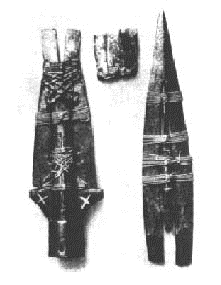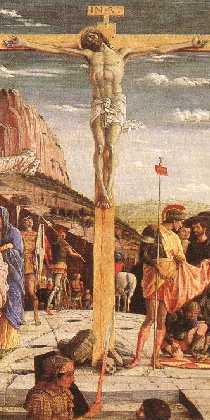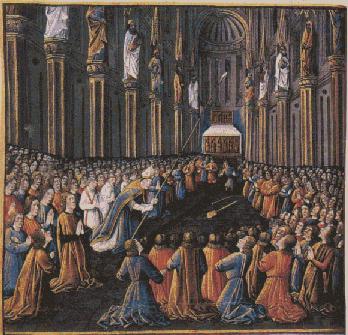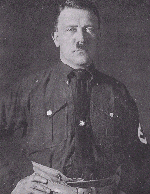|
|||||||||
|
Search for the real Holy Lance |
|||||||||
|
|||||||||
An entire Roman Legion was Martyred for Christ
The Holy Lance was said to have been passed to Saint Maurice
The Holy Lance was said to have been passed to Saint Maurice. Down through the years it fell into the hands of Mauritius (Saint Maurice), the head of a 3rd century garrison of Roman soldiers called the Theban legion. The Theban Legion was a Christian legion of soldiers during the reign of Diocletian. A legion of men consisting of 6,600 (some say: 6,666) soldiers were all Christian. Called Theban legion because there were all conscripted from Thebias in Upper Egypt; they were quartered in the east until they were ordered them to march to Gaul. The area around Thebes has always enjoyed a reputation for its strong, almost fanatical, Christianity. The first monks in the Christian tradition, known as "The Desert Fathers," contained a majority of Thebans, and Theban Christians celebrate many martyrs who have refused to yield their faith to the many persecutions in the first centuries of the church. A traveler on the highway that leads from Geneva to Rome, will notice a small and a very old Swiss town called "Saint Maurice" (now Saint-Moritz or Saint Maurice en Valais or Saint Maurice d’Augaune) in Switzerland. This town was known in the Roman times as "Aguanum", an important communication center. It was there that a Coptic officer named Maurice and 6600 of his fellow soldiers died for the sake of Christ at the hands of the impious Emperor Maximian (285-305 AD). The story of these martyrs, commonly known as the Theban Legion (Alkateeba alTeebia or Alkateeba al-sa'eedia) has been preserved for us by Saint Eucher (aka: Bishop Eucherius of Lyon), the bishop of Lyons, who died in 494 AD. The bishop starts the account of the martyrdom of these valiant soldiers by the following introduction: "Here is the story of the passion of the holy Martyrs who have made Aguanum illustrious with their blood. It is in honour of this heroic martyrdom that we narrate with our pen the order of events as it came to our ears. We often hear, do we not, a particular locality or city is held in high honour because of one single martyr who died there, and quite rightly, because in each case the saint gave his precious soul to the most high God. How much more should this sacred place, Aguanum, be reverenced, where so many thousands of martyrs have been slain, with the sword, for the sake of Christ. Under "Maximinus Daia", also known as Maximian, who was an Emperor of the Roman Commonwealth (Empire) with Diocletian as his colleague (co-Emporer), an uprising of the Gauls known as "Bagaude" forced Maximian to march against them with an army of which one unit was the Thebian Legion composed of 6600 men, in the Spring of 285.. This unit had been recruited from upper Egypt and consisted entirely of Christians. They were good men and soldiers who, even under arms, did not forget to render to God the things of God, and to Caesar the things of Caesar. Diocletian and Maximian transferred the Theban Legion, among other imperial units, to Gaul in an effort to crush the revolt. Landing near Rome, the Theban Legion marched through northern Italy, across the St. Bernard pass, and encamped near the present-day town of St. Maurice. After the revolt was quelled, the Emperor Maximian issued an order that the whole army should join offering sacrifices for the Roman gods for the success of their mission. Although these types of offerings were routine, this offering was also tantamount to recognizing the emperor´s claim to divinity. The order included killing Christians (probably as a sacrifice to the Roman gods). Only the Thebian Legion dared to refuse to comply with the orders. The legion withdrew itself, encamped near Aguanum and refused to take part in these rites. Maximian was then resting in a near-by place called Octudurum. When these news came to him , he repeatedly commanded them to obey his rules and orders, and upon their constant and unanimous refusal, he ordered that the legion should be "decimated". Accordingly, every tenth man was put to death. A second "decimation" was ordered unless the men obeyed the order given but their was a great shout through the legion camp: they all declared that they would never allow themselves to carry out such a sacrilegious order. They had always the horror of idolatry, they had been brought up as Christians and were instructed in the One Eternal God and were ready to suffer extreme penalties rather than do any thing contrary to their religion. When Maximian heard this news, he got angrier than ever. Like a savage beast, he ordered the second decimation to be carried out, intending that the remainder should be compelled to do what they hitherto refused. Yet they still maintained their resolve. After the second decimation, Maximian warned the remainder of the Theban legion that it was of no use for them to trust in their number, for if they persisted in their disobedience, not a man among them would be able to escape death. The greatest mainstay of their faith in this crisis was undoubtedly their captain (Commanding Officer) Maurice, with his lieutenants Candid, the first commanding officer, and "Exuperius" the "Compidoctor". He fired the hearts of the soldiers with the fervor by his encouragement. Maurice, calling attention to the example of their faithful fellow soldiers, already martyrs, persuaded them all be be ready to die in their turn for the sake of their baptismal vow (The promise one makes at his baptismal to renounce satan and his abominable service and to worship only God). He reminded them of their comrades who had gone to heaven before them. At his words, a glorious eagerness for martyrdom burned in the hearts of those most blessed men. Fired thus by the lead of their officers, the Theban legion sent to Maximian (who was still enraged) a reply as loyal as it is brave: ``Emperor, we are your soldiers but also the soldiers of the true God. We owe you military service and obedience, but we cannot renounce Him who is our Creator and Master, and also yours even though you reject Him. In all things which are not against His law, we most willingly obey you, as we have done hitherto. We readily oppose your enemies whoever they are, but we cannot stain our hands with the blood of innocent people (Christians). We have taken an oath to God before we took one to you, you cannot place any confidence in our second oath if we violate the other (the first). You commanded us to execute Christians, behold we are such. We confess God the Father the creator of all things and His Son Jesus Christ, God. We have seen our comrades slain with the sword, we do not weep for them but rather rejoice at their honor. Neither this, nor any other provocation have tempted us to revolt. Behold, we have arms in our hands, but we do not resist, because we would rather die innocent than live by any sin.'' When Maximian heard this, he realized that these men were obstinately determined to remain in their Christian faith, and he despaired of being able to turn them from their constancy. He therefore decreed, in a final sentence, that they should be rounded up, and the slaughter completed. The troops sent to execute this order came to the blessed legion and drew their swords upon those holy men who, for love of life, did not refuse to die. They were all slain with the sword. They never resisted in any way. Putting aside their weapons, they offered their necks to the executioners. Neither their numbers nor the strength of arms tempted them to uphold the justice of their cause by force. They kept just one thing in their minds, that they were bearing witness to him who was lead to death without protest, and who, like a lamb, opened not his mouth; but that now, they them selves, sheep in the Lord's flock, were to be massacred as it by ravaging wolves. Thus, by the savage cruelty of this tyrant, that fellowship of the saints was perfected. For they despised things present in hope of things to come. So was slain that truly angelic legion of men who, we trust, now praise the Lord God of Hosts, together with the legions of Angels, in heaven forever. Not all the members of the legion were at Aguanum at the time of the massacre. Others were posted along the military highway linking Switzerland with Germany and Italy. These were progressively and methodically martyred wherever they were found. Some of the most celebrated saints who were martyred are: During their martyrdom, numerous miracles happened, which undoubtedly largely contributed to the massive conversion of the inhabitants of these regions to Christianity. In Zurich for instance, the three beheaded saints Felix, Regula and Exuperantius miraculously rose, carried their heads on their own hands, walked to the top of a hill, where they knelt, prayed and at last lay down. On the same spot, a large cathedral was later erected. The three saints carrying their heads on their hands appear on the coat of arms and seal of Zurich until today. Saints Victor, Orsus and their comrades were barbarously tortured by Hirtacus, the roman governor of Solothurn. During this torture, several miracles occurred, e.g. the shackles suddenly broke open, the fire was instantaneously extinguished, etc. The lookers-on were thus filled with wonder and began to admire the Theban legionnaires, upon which the furious Hirtacus ordered their immediate beheading. Without the slightest resistance they offered the executors their necks. The bodies of the beheaded Saints then shown in glaring brightness. The bodies of the Saints which were thrown in the river Aar, advanced the bank, stepped out, walked heads on hands, then knelt and prayed at the spot where the Basilica of St. Peter later arose. The bodies of the martyrs of Aguanum were discovered and identified by Saint Theodore the Bishop of Octudurm, who was in office at 350 AD. He built a Basilica in their honor at Aguanum, the remains of which are visible until now. This later became the center of a monastery built about the year 515 AD on the land donated by King Sigismund of Burgundy. Maurice and the Theban Legion became still more important with the rise of the Kingdom of Burgundy. The Burgundians moved into southeast Gaul, as Roman allies, in 443 A.D. after crossing the Rhine in 406. Like the other Eastern barbarian tribes, who had been evangelized by Ulfilas in the fourth century, they were Arian rather than Catholic. They remained Arian despite numerous attempts to convert them to Catholic Christianity. Avitus, Catholic bishop of Vienne, attempted to convert the Burgundian king Gundobad in the 490s A.D. Although tradition says that Gundobad favored the Catholic faith, he refused baptism by Avitus because the monarch feared his Arian nobles would revolt. His son Sigismund, however, was baptized a Catholic around 500, approximately the same time in which Clovis, king of the Franks, became Catholic. Since Burgundy was still Arian, Sigismund had to find a way to balance his Catholic faith with the political realities of an Arian society. While he tried to placate Clovis by publicizing his Catholicism, he never sought to establish Catholicism as the state faith. Since the Arians never had any type of monastic establishment, Sigismund could build a monastic base without offending his Arian bishops and aristocracy. In 515, one year before he became king, Sigismund enlarged and renovated the monastery of St. Maurice at Agaunum. Although previously there had been some sort of hospice and community to minister to pilgrims, Sigismund set out to build something unique. Most monasteries originated and grew from disciples attracted to some holy ascetic. That is, once the fame of an ascetic grew, he would attract disciples to his cave or hut. As the numbers grew, an informal community would spring up with its own rules, while a method of worship typically evolved over a period of time. The monastery of St. Maurice, however, would be unique. It would not evolve, but spring up almost fully developed. Between 515 and 521, Sigismund lavishly endowed its foundation and ensured that it would flourish. He spent huge amounts of money to build a sanctuary, and he transferred monks from other Burgundian monasteries to ensure that the liturgy was kept. The liturgy, known as the laus perennis (perpetual praise), was imported from Constantinople and was distinctive to the monastery of St. Maurice.
|
|||||||||
|
Hitler And The Holy Lance
The one with perhaps the best claim, or at least the oldest provenance is in the Hofburg Museum in Vienna, Austria. This spear, said to be the lance of the Roman soldier Gaius Cassius can be traced back through history to Constantine the Great, the Roman Emperor who first adopted Christianity in the early 4th century. This spear is made of iron. The long tapering point is supported by a wide base with metal flanges depicting the wings of a dove. Within a central aperture in the blade, a hammer-headed nail (thought to be from the cross) has been secured by a cuff threaded with metal wire. According to legend the spear passed from the possession of Gais Cassius, the Roman centurion. According to Ravencroft the lance was possessed by a series of successful military leaders including Theodosius, Alaric (who was responsible for the sacking of Rome), Charles Martel (who defeated the Moslems in 733 AD), Charlemagne and Frederick Barbarossa. A legend grew around the lance that whoever possessed it would be able to conquer the world. Napoleon attempted to obtain the lance after the battle of Austerlitz, but it had been smuggled out of the city prior to the start of the fight and he never got a hold of it. According to the legend, Charlemagne carried the spear through 47 successful battles, but died when he accidentally dropped it. Barbarossa met the same fate only a few minutes after it slipped out of his hands while he was crossing a stream. Napoleon attempted to take the Holy Lance following the Battle of Austerlitz, but, unfortunately for him, it had already been smuggled out of Vienna just prior to the battle, and he never secured it. The spear finally wound up in the possession of the House of the Habsburgs and by 1912 was part of the treasure collection stored in Hofburg Museum. According to Ravenscroft it was in September of that year, while living in Vienna and working as a watercolor painter, that a young Adolf Hitler visited the Museum and learned of the lance and its reputation. Dr. Walter Stein, who accompanied Hitler on that visit, remembered, "when we first stood side by side in front of the Spear of Destiny it appeared to me that Hitler was in so deep a condition of trance that he was suffering almost complete sense-denudation and a total lack of self-consciousness." Hitler later said, "I stood there quietly gazing upon it for several minutes quite oblivious to the scene around me. It seemed to carry some hidden inner meaning which evaded me, a meaning which I felt I inwardly knew yet could not bring to consciousness...I felt as though I myself had held it before in some earlier century of history. That I myself had once claimed it as my talisman of power and held the destiny of the world in my hands..." Hitler saw the lance as his mystical connection with generations of conquering Germanic leaders that had come before him. On March 14, 1938, after he had risen to power as the chancellor of Germany, Hitler annexed the state of Austria and ordered that the spear, along with the rest of the Habsburg collection, be sent to the city of Nuremberg, heart of the Nazi movement. Ravenscroft reveals much of the absolute Satanism which physically possessed Hitler. If you want to get an idea of how the real Antichrist is going to think, act, and plan, you need to read this "inside" account of Ravenscroft. Much of Hitler's actions during World War II make sense only when you realize how his occultist mind set caused him to act the way he did. Secular historians miss much of the point of Hitler's more bizarre actions. After having declared Austria to be a part of the Third Reich the Austrian born Adolf Hitler had the lance loaded on to an armored SS train and taken to Nuremberg on October 13, 1938. There it remained in St. Catherine's Church for the next 6 years until it was removed to a safer, protective underground vault where Lt. Walter William Horn, army serial number 01326328, of the United States Army took possession of it in the name of the US government at 2:10 PM on April 30, 1945; the same day Adolph Hitler and a woman named Eva Braun were reported to have committed suicide in a bunker outside Berlin. It is also the same day that Munich was captured by Patch’s 7th Army unit. Also, on April 30th, 1945, Germany surrendered ending the Third Reich. With the fall the Soviet Union, and the opening up of Soviet archives in addition to recent testimony by former Soviet soldiers who actually captured Hitler's Bunker in Berlin, we have finally been able to confirm that at approximately 3:30 PM, just 80 minutes after the United States took possession of the Spear, that Hitler committed suicide by shooting himself in the head. Today the Holy Lance has been returned to the Hofburg Museum. Is it authentic? General George S. Patton thought so. He became fascinated by the spear after the war and had its history traced. Did Hitler really think
possessing the spear would help him win the war? Other historians
have found Ravenscroft's research suspicious and his book remains
controversial. Alan Baker, author of Invisible Eagle, The History
of Nazi Occultism, thinks Hitler was more interested in getting
a hold of the Hofburg treasures for financial reasons, not occult
reasons. A later book entitled; "Adolf
Hitler and the Secrets of the Holy Lance" (by Buechner &
Bernhart) claims that a replica of the was returned to the Vienna
Museum, while the real lance may have been squirrel-away with other
secret Nazi plundered treasure by Himmler and the SS to South
America or Antarctica. |
*There is some confusion with the name Gaius Cassius Longinus because a person with this name was also with Brutus as one of the leaders of the conspiracy in 44 BC to assassinate Julius Caesar. He and Brutus were defeated by Caesar's supporters, Antony and Octavian, at the battle of Philippi in 42 BC, in the course of which he committed suicide. Whether the term used in association with the lance "Longinus" was meant by early Christians to signify "assassination" instead of the soldier's actual name remains unclear. This person, General Gaius Cassius Longinus would have had to be over 100 years old in the 30's AD, so he is most likely not the actual soldier who placed the spear into the side of Christ. Alternatively, there could be another centurion by the name of Gaius Cassius.
Roman hagiography has come up not only with the soldier's name, but even his post-crucifixion biography.
The soldier, we are told, was called Longinus. Rome's accounts tell us that Longinus was nearly blind – a condition which, I should imagine, would surely have affected his usefulness as a soldier. In any case, the legend assures us that Longinus was not long blind, for after he thrust his spear into the side of Christ, some of the blood and lymph (water) from Jesus fell into his eyes. It was then he exclaimed, "Indeed, this was the Son of God!" as recorded in Mark 15:39.
According to the hagiography, Longinus, now converted, left the army and studied under the Apostles, and ultimately became a monk (and this at a time when there not yet were monasteries) at Caesarea in Cappodocia. There, poor Longinus ran afoul of the law because of his new faith and, we are told, was involved with yet another miraculous cure. The authorities tormented him by forcing all his teeth from his mouth and cutting off his tongue. Despite these tortures, it is said that Longinus continued to speak clearly, then picked up a handy axe and smashed several idols as the governor watched.
When Longinus broke the idols, the demons which had resided in them attacked the governor, depriving him of his sight and driving him mad. This was the occasion for another miraculous healing involving Longinus. The centurion-turned-monk told the governor he would regain his sight when Longinus was dead, so the governor ordered him killed. When he was beheaded, some of his blood splashed into the governor's eyes, restoring his sight. At this miracle, the governor, we are told, was converted to the Christian faith.
We are told the relics of who now is known as "St. Longinus" are located in the church of St. Augustine in Rome.
Reference:
Story of the martyring of the Roman Soldier Mauritius above. See Guardians of the Grail by J. R. Church
"Spear of Destiny" by Trevor Ravenscroft , Paperback, Published by Samuel Weiser, 1987, ISBN: 0877285470 .
Other Great Links at Bible Probe
|
Figure the Odds Real Miracles and Angel Visits Real Angel Visit to a Muslim in Iran Read Muhammad, Terrorist of Prophet? Read
Freemasonry - in league with Satan?
See possible Ghost Pictures The Exodus Happened
|




